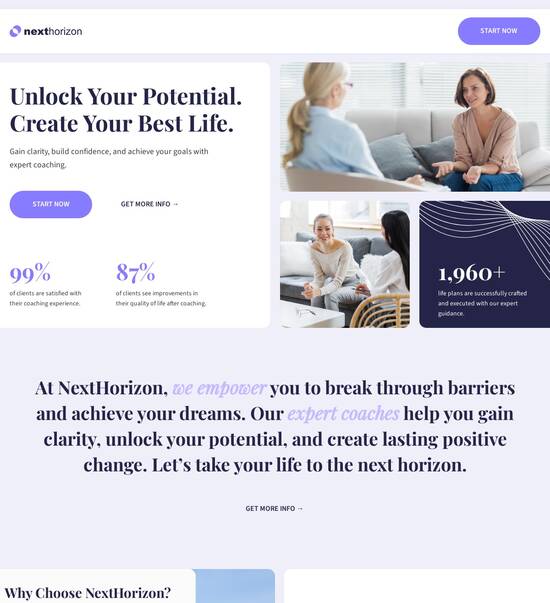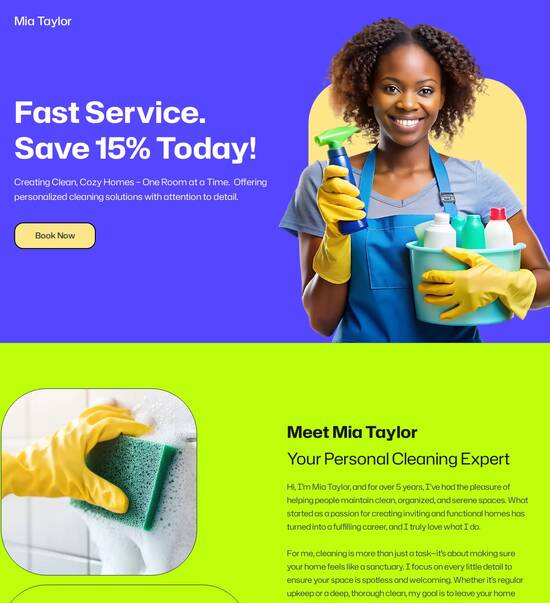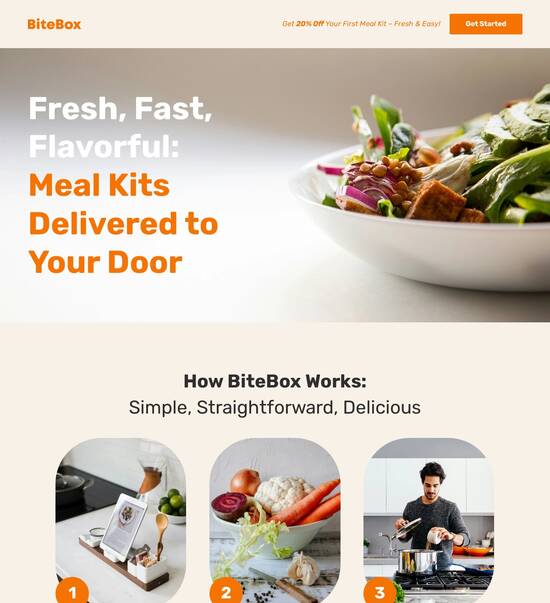
Microsite Template for 3D Printing Companies
Explore Similar TemplatesAbout template
Create customized landing pages for your 3D printing business with Instapage's Microsite template. Tailor your page quickly and efficiently with our 500+ conversion-focused layouts and optimization features, no coding required.
Recommended templates

Easy to build without coding
With the intuitive drag-and-drop builder, anyone on your team can create high-converting pages without any knowledge of code or design. Make enhancements to your landing page with custom widgets using Javascript, HTML/CSS, or third-party scripts.

Multiple layouts for any industry and goal
Select from 500+ landing page layouts built to boost conversions across industry-specific scenarios. Customize them by adjusting fonts, adding images, and generating on-brand content with the AI assistant. Quickly scale with Instablocks® and Global Blocks that you can save, reuse, and update globally.

Loads fast and looks polished on any device
Every template is responsive, which means they present professionally on any device and load blazingly fast with our Thor Render Engine. You can also power them up with Google AMP technology to deliver an unparalleled mobile experience and drive higher conversions.

Robust analytics & experimentation
Get real-time updates and reporting across all your devices, showing the number of visitors, conversions, cost-per-visitor, and cost-per-lead. Launch AI-powered experiments, run A/B tests, and use heatmaps to analyze user behavior, then optimize your landing page to maximize conversions.







Easy to build without coding
With the intuitive drag-and-drop builder, anyone on your team can create high-converting pages without any knowledge of code or design. Make enhancements to your landing page with custom widgets using Javascript, HTML/CSS, or third-party scripts.
Multiple layouts for any industry and goal
Select from 500+ landing page layouts built to boost conversions across industry-specific scenarios. Customize them by adjusting fonts, adding images, and generating on-brand content with the AI assistant. Quickly scale with Instablocks® and Global Blocks that you can save, reuse, and update globally.
Loads fast and looks polished on any device
Every template is responsive, which means they present professionally on any device and load blazingly fast with our Thor Render Engine.
Robust analytics & experimentation
Get real-time updates and reporting across all your devices, showing the number of visitors, conversions, cost-per-visitor, and cost-per-lead. Launch AI-powered experiments, run A/B tests, and use heatmaps to analyze user behavior, then optimize your landing page to maximize conversions.
All the features you need to build lead-generating landing pages
Explore more featuresLearn how to build top-performing landing pages for any goal
FAQs
Leading the way in building high-performing landing pages





An ultimate guide to creating effective landing pages with Instapage
Creating effective landing pages is essential for digital marketers looking to optimize their campaigns and maximize ROI. Instapage provides an all-in-one platform, enabling businesses in sectors such as marketing, education, and financial services to accelerate their lead generation and enhance their online presence. This guide will walk you through the steps needed to leverage Instapage for maximum effectiveness.
Understanding the power of Instapage
Instapage is not just a landing page creator; it's a comprehensive Conversion Rate Optimization (CRO) platform. It offers over 100 customizable templates and lead generation elements that streamline the page creation process. Users can launch high-converting pages effortlessly, regardless of their technical skills.
- Wide variety of templates: Choose from over 100 industry-specific designs to kickstart your landing pages.
- User-friendly tools: Utilize drag-and-drop functionality to create pages without coding.
- Pre-built lead capture elements: Implement forms and calls-to-action without starting from scratch.
Step 1: Crafting landing pages that convert
The first step is to design a landing page that aligns with your campaign goals. Start by picking a template that reflects your brand and message.
- Define your objective: Know whether you're capturing leads, promoting a product, or generating sign-ups.
- Choose your layout: Consider which layout presents information best for your audience.
- Incorporate key messaging: Ensure your landing page speaks directly to your target audience's pain points.
Step 2: Optimize for performance
Optimization is crucial for improving conversion rates. Utilize Instapage's built-in features to analyze and enhance your landing pages.
- A/B testing: Experiment with different headlines, images, and CTAs to find winning combinations.
- Heatmaps: Use heatmaps to see where users click and adjust your design for better engagement.
- Analytics dashboard: Monitor performance metrics to refine your approach continually.
Step 3: Personalize for engagement
Personalization leads to greater user engagement. Use Instapage to deliver tailored experiences for different audience segments.
- Dynamic text replacement: Adjust headlines or text based on user data for relevance.
- AdMap integration: Align specific ads to matching landing pages to maintain consistency.
- Audience-level tracking: Analyze user behavior to enhance future campaigns.
By following these steps, utilizing Instapage's features, and continuously optimizing your landing pages, your marketing campaigns will see improved performance and higher ROI.
Get started with Instapage today! Transform your digital marketing strategy and optimize your campaigns easily and effectively.
People also ask about Microsite template for 3D printing companies
Tailoring a microsite template for 3D printing companies: A deep dive
Understanding the unique needs of 3D printing companies
The 3D printing industry is rapidly evolving, and companies operating in this niche must understand their specific needs to thrive. Specialization is crucial for standing out in a crowded marketplace, as it allows businesses to define their unique selling points (USPs) clearly. For instance, while one company may excel in rapid prototyping, another might focus on custom small-batch production. Identifying and promoting these USPs can enhance a company's market position.
Understanding the target audience is equally essential. The demographics can vary from hobbyists seeking to create personal projects to businesses looking for innovative manufacturing solutions. Educational institutions might also form a significant segment, using 3D printing in STEM education. Companies should segment their audience further by industry, addressing varying needs from sectors like automotive, healthcare, and aerospace, which all have unique requirements and expectations.
The importance of a dedicated microsite for 3D printing ventures
A microsite serves as a focused online presence distinct from a company's main website, designed specifically to address particular products or campaigns. Unlike traditional websites that house a broad range of information, a microsite narrows down the message, making it easier for visitors to comprehend the distinct offerings in the 3D printing sector. This clarity can significantly increase engagement and conversions.
There are numerous benefits to utilizing a microsite for 3D printing companies. Focused messaging allows businesses to engage visitors with precisely targeted content tailored to specific products or services. It enhances user experience by simplifying navigation and streamlining information, leading to faster decision-making. In addition, improved SEO opportunities arise as microsites can target highly relevant keywords unique to 3D printing, boosting visibility in search results.
Essential features of a 3D printing microsite template
One of the foundational elements of a microsite tailored for 3D printing companies is responsive design. Given the diverse range of devices used by potential customers—from desktops to tablets and smartphones—it's essential that the microsite is accessible on all platforms. Features such as card layouts, collapsible sections, and user-friendly interfaces enhance navigability and keep user engagement high, catering to on-the-go visitors.
An intuitive navigation structure is critical for any microsite. Essential navigation elements might include service areas, portfolio demonstration, and case studies that highlight previous work. Employing navigation tips, such as sticky headers or breadcrumb trails, can further streamline access to crucial information, ensuring potential clients find exactly what they need without frustration.
User-friendly interface that allows quick navigation.
Quality visual content that reflects the intricacies of 3D printing.
Clear categorization of services and product offerings.
Content strategies for engaging microsite copy
Crafting compelling headlines is paramount for attracting visitor attention. Effective headlines should convey the unique aspects of the 3D printing services offered while remaining clear and engaging. Using actionable language and relevant keywords can facilitate connection and enhance user interest, prompting further exploration of the site.
Employing descriptive product and service listings is equally important. Clearly outlining the services provided, the types of materials used, and their benefits helps customers make informed decisions. Including testimonials and success stories adds social proof, bridging the gap between initial interest and deeper engagement. Establishing a connection with potential clients can significantly impact conversions.
Craft headlines that emphasize the company's unique offerings.
Focus on detailed descriptions of products and services to enhance clarity.
Incorporate testimonials to build trust and credibility.
Designing interactive elements to enhance user engagement
Incorporating effective Call-to-Action (CTA) buttons is a strategy that can significantly drive conversions on a microsite. Strategic placement of CTAs—throughout content, at the end of articles, or in pop-ups—can prompt users to take desired actions like signing up for newsletters, requesting quotes, or engaging with the services offered. For example, a button saying 'Get Your Custom Quote' can be more enticing than a generic 'Submit.'
Additionally, integrating interactive 3D models and simulations can create a richer user experience. By allowing visitors to manipulate 3D models of products, companies can showcase their printing capabilities in a far more engaging way than static images alone. This interactive approach can help in illustrating complex aspects of products or processes, ensuring user engagement and facilitating a better understanding of what’s offered.
Use action-oriented CTAs to encourage interactions.
Provide interactive 3D models to showcase printing capabilities.
Implement simulations to simplify complex processes.
Utilizing blocks and layouts for a customizable experience
Understanding the variety of blocks available is essential for building a microsite that stands out. Block features can include text, images, video, and gallery options, each serving distinct purposes while collectively enhancing the user experience. Pre-designed blocks are advantageous for companies looking to save time during creation while ensuring that foundational design principles are adhered to.
For a personalized experience, utilizing custom layout options can allow businesses to alter the presentation of information creatively. By mixing and matching blocks, companies can create unique layouts which can spotlight particular services, industry applications, or even client testimonials. Varying arrangements enhances user engagement by providing a fresh experience each time a visitor explores the site.
Explore various block features for artistic flexibility.
Mix and match blocks to create unique layouts.
Focus on user experience through innovative design.
The role of a control panel in microsite management
A robust control panel is vital for effective microsite management. This provides features that facilitate ongoing content management, allowing marketers to make real-time updates, ensuring the site always reflects the latest services and promotions. Important functionalities may include analytics integration, which helps in tracking user engagement metrics, enabling companies to refine their strategies continually.
User management and permissions are also critical aspects of the control panel. With multiple stakeholders involved in site management, it is necessary to have a structured approach to permissions to ensure security. By assigning roles related to content creation and marketing strategies, companies can streamline the editing process, making it more efficient while safeguarding sensitive information.
Utilize analytics integration for ongoing performance tracking.
Simplify user management with structured role assignments.
Allow content creators easy access for efficient updates.
Effective marketing strategies for your 3D printing microsite
Implementing effective digital marketing techniques can significantly enhance the visibility of a microsite. Email marketing is particularly valuable; businesses can nurture leads by sending tailored messages to prospects captured via dedicated forms on the microsite. Additionally, utilizing social media platforms to share content and links to the microsite can increase awareness and generate traffic.
Furthermore, employing SEO strategies is crucial for drawing organic traffic. Best practices include optimizing both on-page elements, such as titles and meta descriptions, and off-page techniques, including outreach for backlinks. Local SEO should not be overlooked, as many customers may be searching for 3D printing services within their geographical area, making it essential to ensure that the microsite is appealing to local searches.
Leverage email marketing for targeted communications.
Utilize social media to boost microsite traffic.
Employ SEO practices to enhance organic visibility.
Frequently asked questions about microsite creation
Microsite creation prompts various inquiries, especially from businesses new to this format. Common questions often include concerns about design flexibility, usability, and how to efficiently manage content updates. Addressing these concerns early can build confidence among stakeholders and lead to successful implementation.
Expert advice is also invaluable when navigating common tasks related to microsite management. Having clear guidelines on how to conduct routine updates or troubleshoot issues can streamline ongoing operations and prevent bottlenecks in content development.
Real-world examples of successful 3D printing microsites
Examining successful 3D printing microsites reveals valuable insights into effective design and content strategies. For example, some companies utilize visually striking layouts that effectively showcase their portfolio while keeping navigation simple. This focus on user experience, combined with clear calls for engagement, has proven successful in converting visitors into customers.
Innovative design approaches also contribute to a microsite's success. Creative use of interactive features, like embedded 3D models or customer showcases, encourages deeper interaction. Observing these trends allows businesses to understand what distinguishes successful microsites from others, helping them adapt their strategies accordingly.
Highlight effective portfolio displays in design layouts.
Utilize interactive features to enhance user engagement.
Analyze visitor behavior to inform design decisions.
Ready to skyrocket conversions?
Supercharge your ad campaigns with high-performing landing pages
Get started














